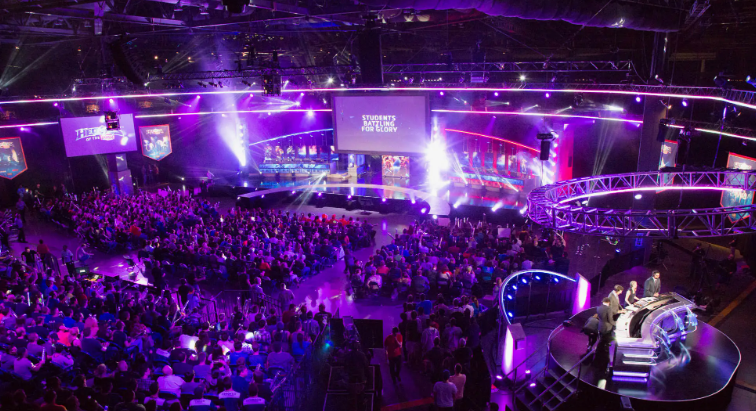In recent years, esports—competitive video gaming—has grown from a niche hobby to a global entertainment phenomenon. With a multi-billion-dollar industry, millions of fans worldwide, and a rapidly expanding infrastructure, esports has firmly established itself as a key player in the entertainment and sports sectors. But as esports continues to grow in both popularity and financial power, one question looms large: Can esports compete with traditional sports?
This article explores the trajectory of esports, examining its current place in the global sports landscape, its potential for future growth, and the challenges it faces as it strives to become a mainstream, long-lasting force on par with traditional sports like football, basketball, and soccer.
The Rapid Rise of Esports
Esports has exploded in popularity in the last two decades, driven by technological advancements, the rise of streaming platforms like Twitch, and an increasing acceptance of video games as a legitimate form of entertainment. Professional esports tournaments now attract millions of viewers worldwide, with events like The International (Dota 2) and League of Legends World Championship offering prize pools in the tens of millions of dollars.
What sets esports apart from traditional sports is its global accessibility. Anyone with a computer, console, or smartphone can participate, watch, or engage with esports. This digital nature means that esports events can be streamed live to millions of viewers across the globe without the need for physical stadiums, allowing for a massive, worldwide audience that traditional sports often can’t reach in the same way.
With esports now a regular fixture in global entertainment, it’s also starting to gain recognition at the collegiate level, with universities offering scholarships for competitive gamers and esports programs becoming part of academic curricula. This institutional support is helping esports gain legitimacy and attract new talent, contributing to its growth.
Financial Growth and Sponsorships
Esports is no longer just a pastime; it’s a booming business. In 2023, the esports industry was projected to reach a value of over $1.5 billion, with revenue coming from sponsorships, advertising, merchandising, media rights, and ticket sales for live events. This financial growth is indicative of the expanding ecosystem around esports, with brands like Nike, Coca-Cola, and Intel investing heavily in esports sponsorships.
The commercial appeal of esports lies in its millennial and Gen Z audience, which brands are eager to connect with. Esports offers advertisers access to a demographic that is often difficult to reach through traditional sports, making it an attractive platform for corporate partnerships. As brands continue to pour money into esports, the industry is becoming more lucrative for players, teams, and organizations, further driving its expansion.
However, esports is still in the relatively early stages of its financial growth compared to traditional sports. While the NBA, NFL, and soccer leagues have been generating billions for decades, esports is still finding its footing in terms of long-term financial stability and mainstream recognition.
Esports as a Spectator Sport
One of the most compelling arguments for esports’ potential to compete with traditional sports is its ability to engage fans in ways that traditional sports cannot. Thanks to streaming platforms like Twitch, YouTube, and Facebook Gaming, esports has created a unique viewing experience that allows fans to interact with players, commentators, and fellow fans in real time. This level of fan interaction has made esports events more than just competitive gaming; they have become social experiences that bring communities together.
The rise of live-streamed esports events has made watching esports more accessible than ever, with fans tuning in from all corners of the world. The viewing experience is often enhanced by real-time commentary, player interviews, and live stats, providing an engaging and interactive broadcast. For younger audiences accustomed to online content consumption, esports offers a more engaging, interactive, and personalized experience than traditional sports broadcasts.
Moreover, esports allows fans to connect with their favorite players and teams on a deeper level. Professional esports players are active on social media, streaming platforms, and content-sharing sites, providing a sense of intimacy and access that traditional athletes may not offer. Fans can watch their favorite players practice, train, and interact with their followers, leading to a stronger emotional connection to the players and the games they love.
Challenges to Overcome: Legitimacy, Infrastructure, and Health Concerns
While the rise of esports is undeniable, it still faces several challenges on its path to becoming a true competitor to traditional sports. One of the key hurdles is its legitimacy as a professional sport. Despite its growing audience and financial success, esports is often still viewed by some as a hobby or form of entertainment rather than a legitimate sport.
Traditional sports have centuries of history and cultural significance, with deeply entrenched infrastructure, leagues, and teams. Esports, in contrast, is still in the process of creating its own governing bodies, formal leagues, and competitive structures. The establishment of global standards for esports competitions, player rankings, and team regulations will be crucial for esports to gain broader acceptance as a professional sport.
Another challenge for esports is the development of infrastructure. While traditional sports benefit from massive stadiums, training facilities, and other physical infrastructure, esports still relies heavily on digital platforms and online tournaments. Although large-scale esports events are held in arenas (such as the League of Legends World Championship), these events are still smaller in scope compared to Super Bowl or World Cup stadiums, limiting the live, physical engagement that traditional sports can offer.
Esports is also facing health-related challenges, particularly around the issue of player longevity. The physical demands of esports may not be as taxing as those of traditional sports, but players still face issues like carpal tunnel syndrome, eyesight problems, and mental fatigue. In a sport where players’ careers are often shorter—ranging from five to 10 years—the lack of emphasis on physical fitness and long-term health could hinder the sustainability of esports as a competitive field. Addressing these health concerns and providing training, wellness programs, and career development opportunities for esports professionals will be essential for the industry to thrive in the long run.
Esports and Traditional Sports: Collaboration or Competition?
As esports continues to grow, it faces the unique opportunity of collaborating with traditional sports rather than solely competing against them. Major traditional sports leagues, such as the NBA, NFL, and MLS, have already started to embrace esports by hosting their own esports tournaments and even creating esports leagues for their games. The NBA 2K League, for instance, is a professional esports league based on the NBA 2K video game, providing an avenue for basketball fans to engage with the sport in a new way.
Moreover, athletes from traditional sports are increasingly getting involved in esports, either as investors, content creators, or even players. FIFA player Tim “TimTheTatman” Betar and NBA star Gordon Hayward are examples of high-profile athletes who have taken part in the world of esports, further solidifying the growing connection between traditional sports and esports.
As the two worlds continue to collide, we may see more crossover events that bridge the gap between esports and traditional sports, providing fans with new forms of entertainment that combine the best of both worlds.
The Future Outlook: A New Era for Sports Entertainment
The future of esports looks promising, with the industry continuing to grow in popularity, revenue, and influence. As the barriers between traditional sports and esports continue to blur, the line between gaming and professional sports will become increasingly indistinguishable. In fact, esports may not necessarily need to “compete” with traditional sports—it could instead coexist alongside them, offering fans new ways to engage with their favorite games and athletes.
The continued rise of esports will depend on sustained growth in key areas like global viewership, infrastructure development, player health, and mainstream acceptance. As the industry matures and more resources are allocated to these areas, esports may well find itself competing on an equal footing with traditional sports in terms of fan base, commercial revenue, and cultural influence.
Ultimately, whether esports becomes a direct competitor to traditional sports or remains a complementary form of entertainment, it’s clear that esports is here to stay and will continue to play a prominent role in the future of sports entertainment.


